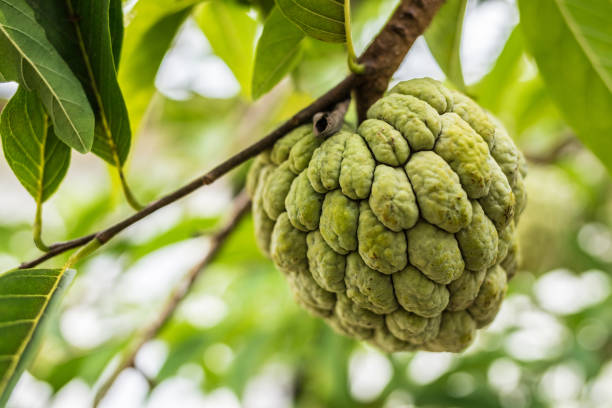India’s diverse climate and soil conditions make it an ideal place for cultivating a wide variety of fruit trees. Among these, the Custard Apple, commonly known as Sitaphal, stands out for its adaptability, nutritional benefits, and minimal care requirements. This article explores why planting custard apple trees is an excellent decision for Indian homeowners, farmers, and eco-conscious citizens alike.
What is Custard Apple (Sitaphal)?
The custard apple is a tropical fruit that belongs to the Annonaceae family. Its scientific name is Annona squamosa, and it is native to the tropical Americas but widely cultivated in India, especially in states like Maharashtra, Madhya Pradesh, Andhra Pradesh, and Tamil Nadu.
The fruit has a knobby green skin and creamy, sweet, custard-like pulp inside. Rich in nutrients and antioxidants, Sitaphal is a low-maintenance tree that thrives in hot and dry conditions, making it perfect for Indian summers.
Why Choose Custard Apple for Your Garden?
1. Low Maintenance
Custard apple trees require minimal care once established. They are drought-tolerant and pest-resistant, making them ideal for busy gardeners and those with limited water supply.
2. Thrives in Indian Summers
Sitaphal trees are sun-loving and can withstand extreme heat. Their deep roots help them survive dry spells, which is why they are commonly seen flourishing in semi-arid regions of India.
3. Fast Growth & Quick Yield
Under favorable conditions, custard apple trees begin to bear fruit within 2-3 years of planting. This makes them a rewarding investment for those seeking quick returns from home gardening or orchard farming.
4. Rich in Nutritional Value
Sitaphal is a nutritional powerhouse, rich in Vitamin C, potassium, magnesium, and dietary fiber. It helps improve digestion, boosts immunity, and supports heart health.
5. Eco-Friendly and Soil Enriching
Like most fruit trees, custard apples help in reducing carbon dioxide levels, provide shade, and improve soil fertility through natural leaf fall and root activity.
Best Time and Conditions to Plant Sitaphal
- Ideal Time: Plant during monsoon (June to August)
- Sunlight: Needs full sun exposure
- Soil: Prefers well-drained sandy or loamy soil
- Watering: Moderate; avoid overwatering
- Spacing: 4-6 meters between trees
How to Plant Custard Apple Trees
- Site Selection: Choose a location that gets 6-8 hours of sunlight daily.
- Pit Preparation: Dig a pit of size 60x60x60 cm and fill it with a mix of topsoil, compost, and sand.
- Planting: Place the sapling gently, cover roots with soil, and water immediately.
- Mulching: Apply organic mulch to retain moisture and suppress weeds.
- Fertilization: Add well-rotted compost or cow dung twice a year—once before flowering and once after fruiting.
Companion Trees to Grow with Sitaphal
Planting a variety of fruit trees in your garden not only adds diversity but also enhances cross-pollination and soil health. You can consider pairing your custard apple trees with:
- Mango trees – the king of fruits
- Guava trees – rich in Vitamin C
- Lemon trees – great for year-round yield
- Papaya trees – fast-growing and productive
- Jamun trees – native and medicinal
- Banana trees – high yield all year round
- Pomegranate trees – antioxidant-rich fruit
- Sapota (Chikoo) trees – sweet and long-bearing
- Coconut trees – shade and sustainable yield
These combinations will turn your garden into a self-sustaining food forest that supports biodiversity.
Harvesting and Storing Custard Apples
- When to Harvest: Fruits are ready when the skin turns light green and starts to crack slightly.
- How to Pick: Use scissors or gently twist the fruit by hand.
- Storage: Keep unripe fruits at room temperature. Once ripe, refrigerate to extend shelf life.
Common Pests and Diseases
Though hardy, custard apple trees can be affected by:
- Mealybugs – treat with neem oil
- Fruit borers – use pheromone traps
- Powdery mildew – spray with diluted milk or sulfur-based fungicide
Regular inspection and use of organic pesticides can help keep these issues under control.
Environmental and Economic Benefits
For the Environment:
- Reduces air pollution
- Improves biodiversity
- Enhances green cover
For the Economy:
- Source of income for small farmers
- Fruit sells at a premium during off-season
- Supports local markets and ecosystems
Conclusion
Planting custard apple (Sitaphal) trees is one of the best decisions for those seeking a low-maintenance, nutrient-rich, and eco-friendly addition to their garden or farm. Not only does it offer delicious fruits, but it also contributes to a greener and healthier planet.
If you are planning a fruit tree plantation in India, don’t limit yourself—explore other wonderful choices like mango, banana, pomegranate, and coconut to build a balanced and productive home garden.
Frequently Asked Questions (FAQs)
Q1. Is Sitaphal suitable for small home gardens?
Yes, Sitaphal trees can be pruned to manage their size, making them ideal for small gardens or even large pots.
Q2. How long does it take for a custard apple tree to bear fruit?
Generally, 2-3 years from planting under favorable conditions.
Q3. What is the best soil for growing Sitaphal?
Well-drained sandy loam or red soil is ideal for custard apple cultivation.
Q4. Can custard apple trees grow in coastal areas?
Yes, but ensure the area is not waterlogged. They thrive best in semi-arid and tropical climates.
Q5. Do I need to plant more than one tree for fruiting?
Although they are self-pollinating, planting 2-3 trees nearby can increase fruit yield.
Q6. What are some other good fruit trees for Indian gardens?
You can also grow guava, jamun, sapota, and lemon trees.
Q7. Where can I find more tree plantation guides?
Visit treesplantsinfo.com for expert insights, planting tips, and eco-friendly gardening inspiration.
Make your garden thrive—plant a Sitaphal today and enjoy its sweet, sustainable rewards!
